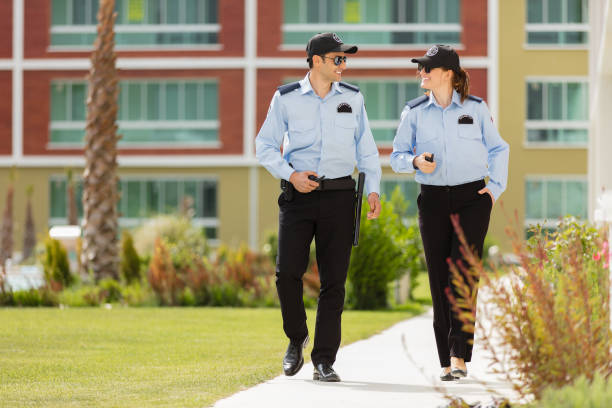
Visible and competent security services can make a world of difference in enhancing a feeling of safety in a workplace, event venue, accommodation or other public settings. When those security services are seen to be working alongside local law enforcement, it is even more of a comfort – and more off-putting to any would-be troublemakers. Let’s talk about how encouraging collaboration between your security patrol and law enforcement can provide mutual benefits for both organisations, and what you can do to foster a successful partnership.
Why should collaboration be the goal?
It’s important to understand the context of the relationship between private security and public police forces in the UK. In recent times, private security firms have become more and more popular due to their versatility and specialisation. Meanwhile, public law enforcement has been facing difficulty due to challenges such as budget cuts and a concerning rise in crime rates.
Now that private security firms have the right kind of resources and training to hand, they are more equipped than ever to support (and be supported by) police forces in their shared goal of promoting public safety and preventing crime. This is preferable to the two forces being seen as opposing powers.
What benefits can you expect from integrating these agencies?
- Enhanced public safety – the main goal of both private security and law enforcement should always be keeping people safe and protected. By working together to deter criminals, respond quickly to incidents and present a united front, public safety will benefit.
- Maximised resources – working together allows for the sharing of resources, whether this means personnel, intelligence, experience or equipment. This gives both teams a greater capacity to respond to any incidents that may arise.
- Improve information sharing and communication – by sharing information between each other, both security patrols and law enforcement will have a more comprehensive understanding of a situation and the potential threats to it. This makes decision-making easier and improves situational awareness.
- Collaborative responses to incidents – by being in a situation where they can respond to incidents as collaborative force, the risk of confusion or miscommunication is minimised.
- Increased deterrence – as always, there is safety in numbers. Security patrols and law enforcement working together serves as a very visible and intimidating deterrent to any criminals.
- More community engagement – public and private sectors being seen to work together with the shared goal of protecting the public is likely to encourage more community engagement for both forces, and build trust.
- Professional development – joint training exercises and briefings, the sharing of skills and expertise, and the experience of working alongside each other is a great development opportunity for members of both forces.
Where to start
Here are some of the key factors to consider when looking to integrate your private security patrol with local law enforcement.
Defining roles and responsibilities
Your security personnel can only perform to the best of their ability when they have a clear understanding of exactly what is required of them in their role. Clarity regarding both the separate and shared responsibilities of security patrols and law enforcement is paramount to the seamless integration of their operations. Make sure protocols are well-defined and explain exactly how and when security personnel should escalate incidents to the police, and consider including transparent guidelines for interactions with law enforcement officers. By removing ambiguity, you enhance operational efficiency.
Encourage the sharing of information
At a time when the sharing of information (both factual and false) is easier than ever, being able to effectively communicate data is essential to maintaining visibility in potentially dangerous situations. Protocols should be made clarifying how, when and why information is shared, for example CCTV footage, observations, or incident reports. Being able to leverage insights such as these in a collaborative way helps to strengthen collective responses to security threats.
Make comprehensive response plans
All parties involved should know exactly how any emergency incident will be responded to. Plans should be made dictating clear procedures for a wide variety of possible incidents, as well as how incidents may escalate depending on the variables at play. Both parties should be agreed on the best practices and overall priorities when it comes to safeguarding lives and property. Failing to prepare these coordinate responses could have severe consequences.
Challenges
Of course, the integration of two such forces isn’t without its challenges. Cultural and organisational differences across the two sectors can impede the creation of protocols, and issues surrounding legal liability and the sharing of information can hinder the defining of roles and flow of communication. It’s important that any joint ventures are built on a foundation of trust and mutual respect, and that the shared goal of public safety comes before and pre-existing biases.
An example
Here is an example of how a security patrol and local law enforcement working together can prevent a crime that hasn’t yet been committed.
In this scenario, a private security patrol is monitoring a busy shopping centre during peak weekend hours. Security personnel notice a group of individuals who appear to be loitering outside of and paying close attention to an electronics store. They appear to be making efforts to conceal things within their clothing, avoid the gaze of security personnel, and hide their faces.
This potential threat is communicated to a designated law enforcement liaison, with detailed descriptions of the individuals and their behaviour. This information is then shared with nearby police units to coordinate a response. Joint surveillance is then made possible, and the individuals are intercepted as they attempt a smash and grab robbery.
The sharing of information and joint response to the threat helped to prevent unnecessary harm, damage, and financial losses.
Enhance your security
If you’re looking for security patrol services, of for more information on how you can encourage collaboration between your security personnel and local law enforcement, reach out to our All Time Security experts today.



